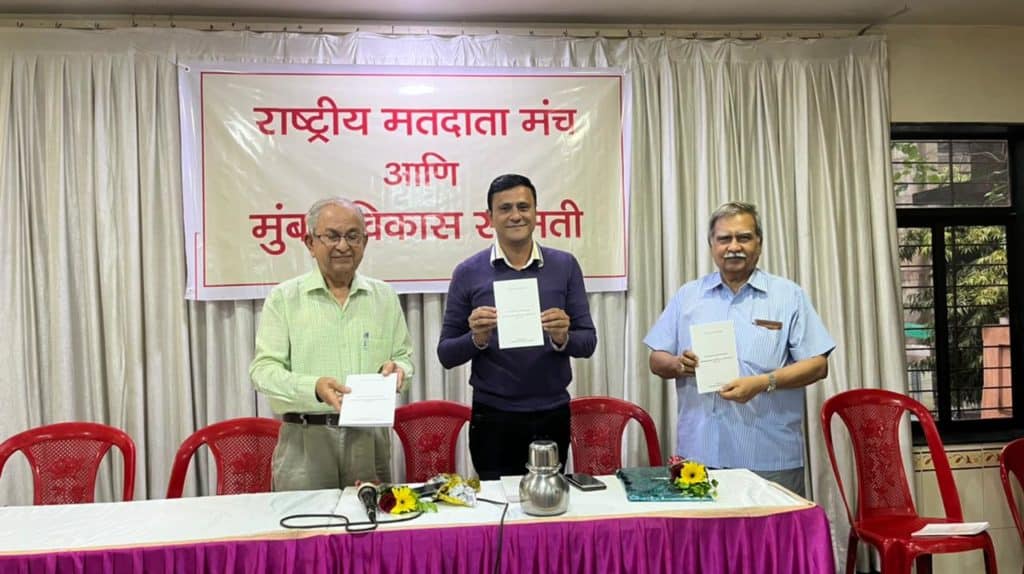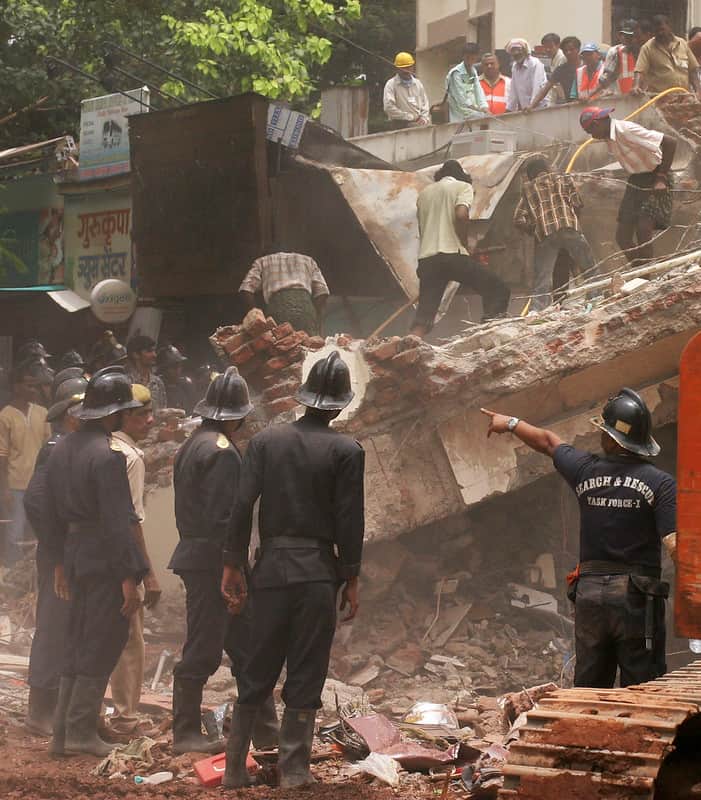Year after year, images of people wading their way through knee-deep water, potholes, and building collapses are splashed across newspapers and TV screens as soon as monsoons begin in Mumbai. Mumbaikars endure unsafe commutes without many choices. They register complaints on various platforms, and while Brihanmumbai Municipal Corporation (BMC) authorities claim to take note of their grievances, little materialises. A new report analysing councillors’ performance confirms this.
BMC’s Councillors “do not appear to be interested in permanently solving day-to-day civic problems”, states the report, released to the public earlier in July ahead of the civic body elections. “Instead, they show more interest in items like de-reservation of plots, change of use of plots, slum improvement schemes through private contractors, renaming of roads/chowks etc,” the report – titled ‘Evaluation of Performance of BMC (2017-22)’ – adds.
The report is a collaborative effort between Rashtriya Metadata Manch (RMM) and Mumbai Vikas Samiti (MVS), two sister organisations where the former is an activists-led initiative, the latter is an organisation of retired BMC engineers and officials. From 2017-18 to 2020-21, Councillors raised 8,934 questions, of which 14 per cent were on the naming and renaming of roads. In the same years, BMC had received 2.66 lakh complaints by the citizens on various issues.
“Despite promises being made (before elections) to solve issues related to potholes, water supply, hawkers, and so on, deliberations on them have been inadequate,” the evaluation report reads. The BMC was under the leadership of Shiv Sena until March when the term of many of its corporators expired. The report, published in February, ranks BMC’s performance at 38 per cent on various parameters such as town planning, effective governance, and handling of the city’s general problems. It awards 28.25 per cent to the Sena for keeping their poll promises.
BMC efforts to reduce potholes have failed
One of the promises Shiv Sena made in its manifesto was a pothole-free Mumbai. “Year after year, the corporation spends huge amounts to make roads pothole-free, but in vain. As soon as monsoon visits, the work of repairing roads becomes inevitable,” the report reads.
While some efforts have been made to make Mumbai pothole-free, they were unsuccessful. The report added and accorded the Sena two out ten marks on their promise and the BMC four marks on their work. Shiv Sena spokesperson Manisha Kayande was invited for the release of the report but could not make it due to rains.
Maharashtra Navnirman Sena’s Sandeep Desai, who was present at the launch event, said, “For a while now, big companies like L&T become ineligible for road contracts because they fail to meet certain tender conditions, like location and radius of companies that can apply. Such things need to be reconsidered.”

In 2018, the Bombay High Court directed the civic body and the state government to repair all arterial roads in the city and devise a uniform mechanism to redress citizens’ grievances related to bad roads and potholes. This was in response to a petition filed by advocate Ruju Thakker claiming that the two authorities were in contempt of court due to non-compliance.
While hearing the contempt petition on July 8, days after a 37-year-old biker died in Thane after bumping into a pothole, the court pulled up the two civic bodies and said, “You may not be able to prevent potholes, but once potholes come to your knowledge, you must prevent accidents. It is happening every year and people are dying. Is it not your responsibility to take action? Such incidents take place every year as soon as the first monsoon rains arrive. You (civic bodies) are not at all equipped (to prevent it).”
Flooding continues despite promises
In the aftermath of the 2005 floods in Mumbai, the Chitale committee had recommended setting up eight pumping stations to pump the excess rainwater into the sea. One of Sena’s BMC poll promises was the commissioning of the 7th and the 8th pumping station at Mogra Pada in Andheri and Mahul in Chembur.
However, land disputes befell both. The proposed land for Mahul station became a dispute between the state and the Centre, so an alternative site was decided on and a tender was floated. That too was scrapped after six months, when the site was declared a part of the no-development zone under Coastal Zone Management Plans maps published by the National Coastal Zone Management Authority in January 2022.
In July 2021, the BMC deposited a land value of Rs 43 crore in the Bombay High Court, which would be given to the owner after the dispute is resolved, and made plans to kickstart the work. But a year later, the work at Mogra is yet to start. The work of designing, planning and environmental clearance is going on. The on-ground work will start after getting permissions,” a BMC official told Mid-Day.
The evaluation report gives four points to Sena and three points to the BMC for getting the paperwork started. “BMC is continuously working on the various stormwater drainage works since the deluge of 26.7.2005 but with limited success. The completion of work cannot be predicted. Flooding in the Hindmata area continued in the 2021 monsoon,” the report stated.
BMC planned to release excess rainwater at Hindmata into the nullah by constructing tanks and placing dewatering pumps to push the water into those tanks. However, Hindmata and several usual flood-prone areas were waterlogged on June 30, when rainfall levels reached the city’s average 78 inches. Notably, the areas remained clear of accumulated water in mid-July even after heavy rainfall, coupled with high tides, pounded the city.
Read more: The cost of setting shop in the flood prone area of Hindmata junction
Unauthorised buildings stand and fall
In 2021, at least 12 people, including eight children, died after two floors of an illegal three-storey residential building in Malvani collapsed on an adjoining single-storey house. While hearing the matter on its suo moto PIL, the Bombay High Court called the tragedy a “man-made disaster” and said there existed absolute “lawlessness” in the municipal wards in Mumbai.
“Mumbai is one of the worst examples of illegal constructions due to pressure from builder lobby, criminal gangs and some unscrupulous elected representatives,” the evaluation report alleges. It added that the “unwillingness” of the corporation and the state government to punish culprits who flout norms seems to be encouraging illegal construction.

Since 2016 BMC received 67,809 complaints about illegal construction but acted only upon 29,273 of them. “There are several malpractices in the housing sector and BMC is indirectly encouraging these unscrupulous persons by regularising the illegal constructions,” the report alleges. It gives awards 2 marks to the BMC on their efforts to curb illegal constructions.
The latest building to collapse in Mumbai was in the midnight hours of June 28 in Naik Nagar Housing Society at Kurla east. It left 19 dead and 14 injured. The society had four buildings and soon after the collapse, BMC ordered demolition of the other three buildings as well. A BMC official, on the condition of anonymity told Hindustan Times.
“All the four buildings in that compound were declared dilapidated. Between 2015 and 2016, we had sent several notices to the tenants and owners urging them to carry out a structural audit of the premises since it was in a dilapidated state. In May 2016, the BMC had also disconnected water, sewage and electricity lines in all the four buildings.”
The civic body had to back off when the occupants carried out a structural audit in June 2016 and declared the building as ‘repairable’.
Need for public participation
The report urges BMC to set up a ‘City Development Committee’ consisting of state officials, corporation officials, elected representatives, independent experts and citizen activists to decide on developmental matters, especially concerning land use and allocation. It also suggests that the BMC invite public participation in budget-making. “This needs to be propagated to bring out innovative suggestions and priorities can be reshuffled to suit the genuine public need,” the report states. Furthermore, it advises area committees consisting of “public-spirited” citizens who would oversee civic functions like maintenance of roads and overall sanitation. “A vision document should be prepared by the BMC with full public participation keeping in view the possible overall development during the next couple of decades. Developmental Plan should be aligned with this vision document.”